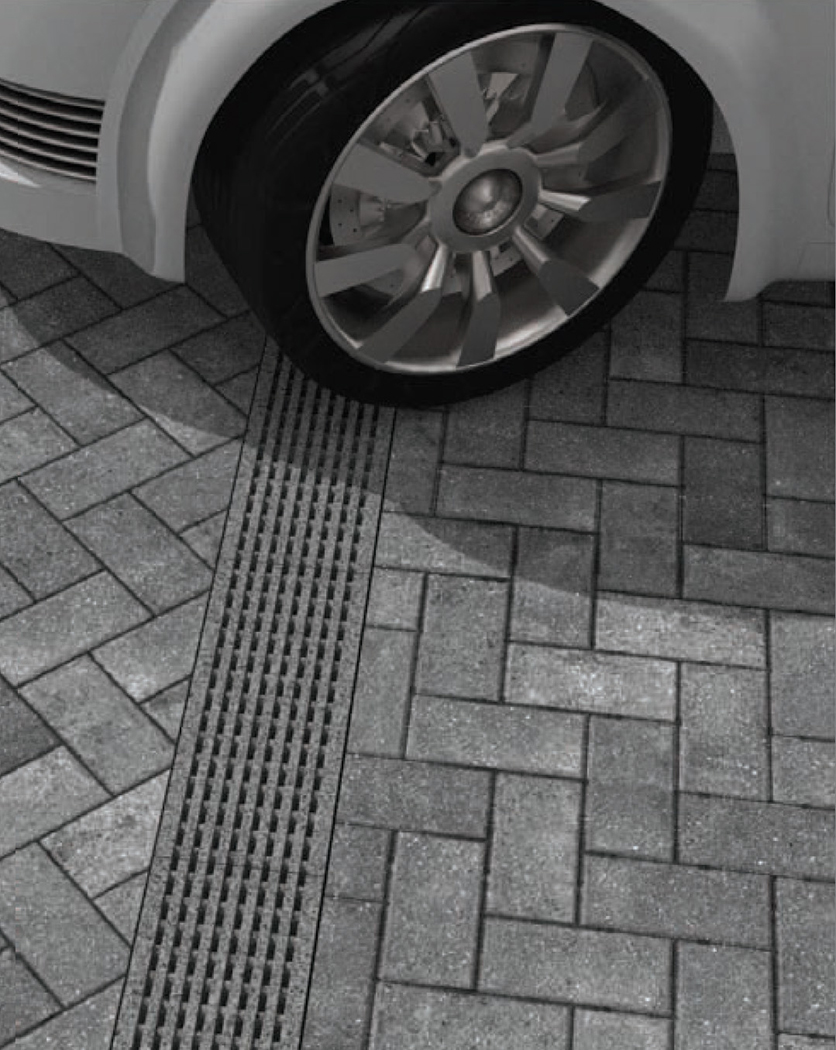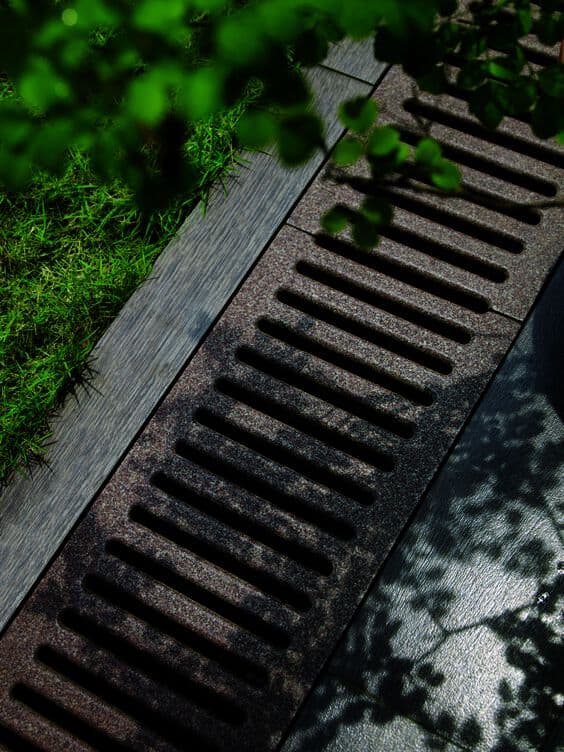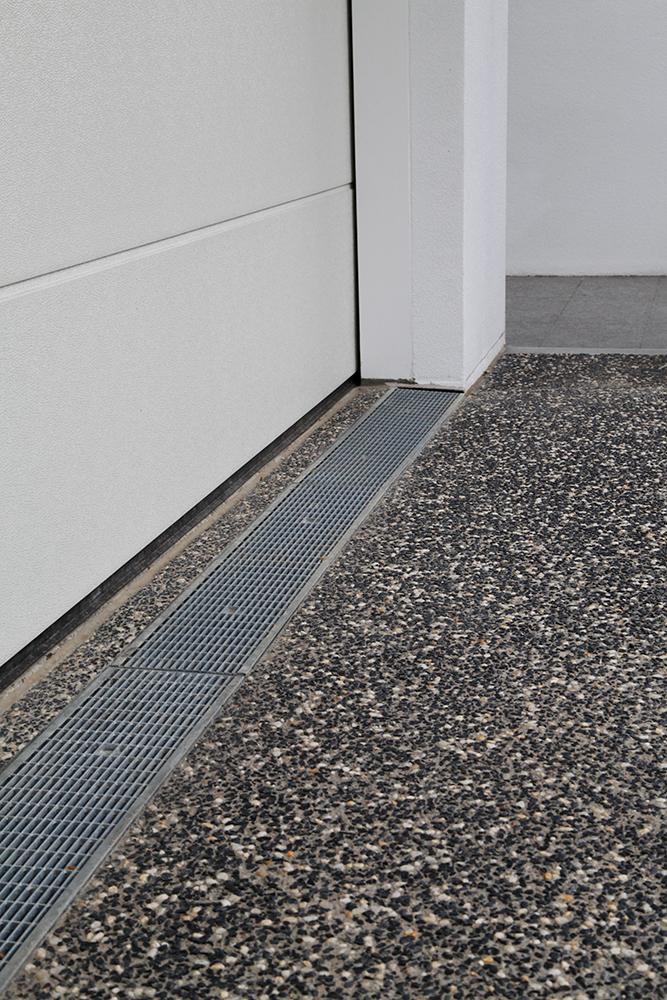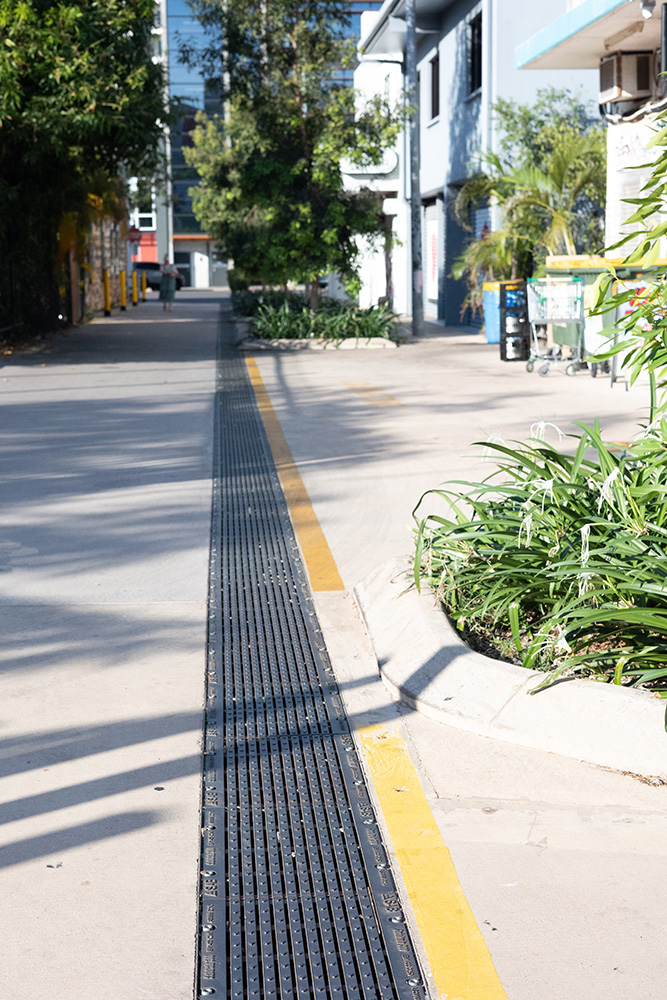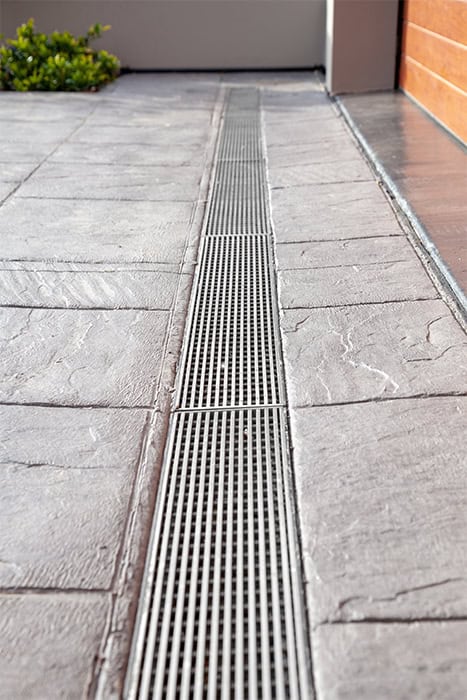What is a Drainage Grate?
A drainage grate is a cover installed over a trench drain channel, designed to filter out debris whilst allowing water to flow into the drain below. These grates play a crucial role in stormwater management systems by preventing leaves, dirt and other debris from clogging the drainage channels, which can lead to water pooling and potential flooding. Available in various materials, designs and load capacities, trench drainage grates can be tailored to specific project needs; whether its for residential landscaping, commercial parking lots or industrial sites. If you’re just starting with trench drainage, check out our guide on innovative trench drain designs for modern landscaping to explore different styles.
When & Why Install a Drainage Grate?
The installation of a drainage grate becomes essential in areas where water runoff needs to be managed effectively. Driveways, sidewalks, parking lots and gardens are prone to water accumulation, especially during heavy rainfall. Drainage grates help divert water away from these surfaces, preventing erosion, puddling and damage to structures. Installing a grate over your trench drain protects the system from clogs, ensuring long term functionality and reducing maintenance costs. For instance, in residential projects, choosing the right trench drain for a driveway is crucial- check out our post on driveway drainage tips to learn more.
Importance of Drainage Grates
Beyond their functional purpose, drainage grates also contribute to the safety and aesthetic appeal of an outdoor space. Grates with anti-slip surfaces improve pedestrian safety by reducing the risk of slips and falls, even in wet conditions. A well designed grate can also complement the surrounding architecture or landscape, offering both form and function. Additionally, grates help manage environmental concerns, such as controlling stormwater runoff to avoid overwhelming city sewer systems. Learn how slot drains can enhance the efficiency of urban drainage systems while minimizing visual impact.
Features of Drainage Grates
When selecting a drainage grates, it’s important to consider features that enhance functionality and safety. Below are some key features to think about.
- Anti-SlipIn areas where water runoff is frequent, such as around pools, walkways or driveways, slip resistant surfaces are critical. Grates designed with antislip nodules can provide better traction underfoot to help prevent the risk of accidents. This feature is particularly important in high traffic zones where safety is a top priority.
- LockdownSome grates come with a lockdown feature, which secures the grate firmly in place. This is especially useful in high traffic or industrial areas where grates may need to handle heavy loads. Lockdown mechanisms prevent the grate from shifting, enhancing the durability of the drainage system and ensuring user safety.
- Heel GuardFor areas with pedestrian traffic, especially in urban or commercial spaces, heel guard grates are essential. These grates are designed with narrow slots to help prevent high or thin heels from getting caught, minimising the risk of injuries and damage to the footwear. Heel guard grates are commonly used in high foot traffic areas such as public walkways or plazas.
- Chemical ResistanceIn environments where the grate may be exposed to harsh chemicals - such as industrial sites or factories, chemical resistant grates are crucial. Materials like stainless steel or polypropylene are often used in these settings as they have a higher resistance against corrosive substances, ensuring a longer lifespan for the drainage system.
These features can vary depending on the specific needs of your project, and choosing the right combination will ensure optimal performance and safety. If you’re considering these factors in your trench drainage project, you might want to explore our article on how to choose the right trench drain for your project.
Drainage Grate Materials
The materials of the drainage grate significantly impacts its performance, durability and appearance. Here’s an overview of popular options
- Galvanised SteelGalvanized steel grates offer excellent corrosion resistance and durability, making them ideal for outdoor applications like driveways and parking lots. They are cost-effective, strong enough for moderate to heavy loads, and provide long-lasting performance.
- Stainless SteelFor areas requiring superior corrosion resistance, stainless steel is the go-to material. It is particularly suited for coastal regions or chemical processing facilities, where exposure to harsh elements is common. In addition to its strength, stainless steel has a sleek modern appearance.
- Cast IronKnown for its robustness, cast iron grates are typically used in high traffic zones, such as roads and industrial sites. Cast iron grates are often are heavier than other materials, providing stability & durability.
- PolypropylenePolypropylene grates are affordable, making it perfect for residential applications like gardens or driveways (if the load class is suitable). Polypropylene is resistant to chemicals and rust, but it may not be suitable for high load areas.
- StoneStone grates offer a natural aesthetic. Often used in high end landscaping projects to ensure the drainage blends perfectly with the environment.
- Pressed MetalThinner but durable, pressed metal grates are often used in areas requiring minimalist or modern aesthetic. These are suitable for areas with light to moderate traffic and are favoured for their sleek, contemporary appearance.
For more guidance on selecting the right material for your trench drain, check out our article on comparing trench drain materials
(L-R) Stone, Galvanised, Cast Iron, Stainless Steel
Guide to Choosing Which Grate is Suitable
The materials of the drainage grate significantly impacts its performance, durability and appearance. Here’s an overview of popular options
- Galvanised SteelGalvanized steel grates offer excellent corrosion resistance and durability, making them ideal for outdoor applications like driveways and parking lots. They are cost-effective, strong enough for moderate to heavy loads, and provide long-lasting performance.
- Stainless SteelFor areas requiring superior corrosion resistance, stainless steel is the go-to material. It is particularly suited for coastal regions or chemical processing facilities, where exposure to harsh elements is common. In addition to its strength, stainless steel has a sleek modern appearance.
- Cast IronKnown for its robustness, cast iron grates are typically used in high traffic zones, such as roads and industrial sites. Cast iron grates are often are heavier than other materials, providing stability & durability.
- PolypropylenePolypropylene grates are affordable, making it perfect for residential applications like gardens or driveways (if the load class is suitable). Polypropylene is resistant to chemicals and rust, but it may not be suitable for high load areas.
- StoneStone grates offer a natural aesthetic. Often used in high end landscaping projects to ensure the drainage blends perfectly with the environment.
- Pressed MetalThinner but durable, pressed metal grates are often used in areas requiring minimalist or modern aesthetic. These are suitable for areas with light to moderate traffic and are favoured for their sleek, contemporary appearance.
For more guidance on selecting the right material for your trench drain, check out our article on comparing trench drain materials
(L-R) Stone, Galvanised, Cast Iron, Stainless Steel
Maintenance & Care for Drainage Grates
Proper maintenance is crucial to keeping trench drainage systems functioning optimally. Key maintenance steps include:
- Regular cleaningRemove leaves, dirt, and other debris from the surface of the grate to prevent clogs.
- Periodic inspectionsCheck the grate for signs of damage, corrosion, or wear, especially in high-traffic areas. Early detection of issues can prevent costly repairs later.
- Drainage channel cleaningEnsure the trench itself remains clear of blockages to allow water to flow freely.
Routine care is vital for all types of drainage systems, and you can read more in our detailed post on drainage system maintenance.
Replacing Broken Trench Drain Grates
Even the most durable grates may require replacement after years of use, especially in high-traffic areas. When replacing a broken or damaged grate:
- Match the load capacityEnsure the new grate can withstand the required load.
- Consider material upgradesIf your original grate corroded quickly, upgrading to stainless steel or a similar material may be worth the investment.
- Measure accuratelyPrecise measurements are necessary to ensure a seamless fit, particularly if the grate is part of a modular system.
For more tips on maintaining and replacing drainage systems, visit our blog post on replacing broken trench grates
Choosing the right trench drainage grate is crucial for the efficiency, safety, and longevity of any drainage system. By considering factors such as material, load capacity, and essential features like anti-slip surfaces, heel guard, and chemical resistance, you can select a grate that not only performs well but also suits the specific requirements of your project. Whether you opt for the durability of galvanized steel or the sleekness of stainless steel, understanding the available options ensures your drainage system remains reliable and effective over time.
